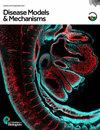BALB/c.mdx62 小鼠表现出肌肉萎缩性病理,是杜氏肌营养不良症的新型模型。
IF 4
3区 医学
Q2 CELL BIOLOGY
引用次数: 0
摘要
杜兴氏肌肉萎缩症(DMD)是一种破坏性的单基因骨骼肌消耗性疾病。虽然临床前研究已报道了许多药物和基因干预措施,但很少有临床试验取得显著疗效。由于缺乏合适的临床前小鼠模型,确定治疗潜力可能受到限制。对具有不同背景品系和突变的模型进行更严格的测试,可能会确定临床成功的治疗方法。在此,我们报告了 DMD 小鼠模型的产生情况,该模型由 CRISPR 诱导 Dmd 基因 62 号外显子的缺失,是首次在 BALB/c 小鼠中产生的模型。对 3 个月、6 个月和 12 个月大的小鼠进行的分析证实了 Dp427 蛋白表达的缺失以及由此导致的四肢肌肉和膈肌的萎缩性病理变化,有证据表明存在中心核纤维、炎症标志物和纤维化增加、肌肉功能进行性下降以及骨小梁发育受损。与现有模型相比,C.mdx62 小鼠是一种新型的 DMD 模型,在免疫反应和肌肉表型方面存在相关变化。它是对临床前模型工具箱的重要补充,可用于开发治疗策略。本文章由计算机程序翻译,如有差异,请以英文原文为准。
The BALB/c.mdx62 mouse exhibits a dystrophic muscle pathology and is a novel model of Duchenne muscular dystrophy.
Duchenne muscular dystrophy (DMD) is a devastating monogenic skeletal muscle wasting disorder. While many pharmacological and genetic interventions have been reported in preclinical studies, few have progressed to clinical trials with meaningful benefit. Identifying therapeutic potential may be limited by availability of suitable preclinical mouse models. More rigorous testing across models with varied background strains and mutations may identify treatments for clinical success. Here we report the generation of a DMD mouse model, with a CRISPR-induced deletion within exon 62 of the Dmd gene, and the first generated in BALB/c mice. Analysis of mice at 3, 6, and 12 months of age confirmed loss of Dp427 protein expression and resultant dystrophic pathology in limb muscles and the diaphragm, with evidence of centrally nucleated fibers, increased inflammatory markers and fibrosis, progressive decline in muscle function, and compromised trabecular bone development. The C.mdx62 mouse is a novel model of DMD with associated variations in the immune response and muscle phenotype, compared with existing models. It represents an important addition to the preclinical model toolbox for developing therapeutic strategies.
求助全文
通过发布文献求助,成功后即可免费获取论文全文。
去求助
来源期刊

Disease Models & Mechanisms
医学-病理学
CiteScore
6.60
自引率
7.00%
发文量
203
审稿时长
6-12 weeks
期刊介绍:
Disease Models & Mechanisms (DMM) is an online Open Access journal focusing on the use of model systems to better understand, diagnose and treat human disease.
 求助内容:
求助内容: 应助结果提醒方式:
应助结果提醒方式:


